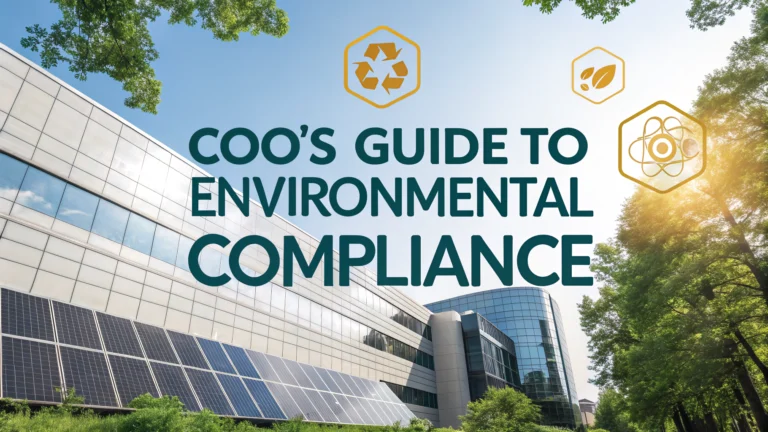Environmental compliance presents unique challenges for Chief Operating Officers tasked with balancing regulatory requirements against operational efficiency and business growth.
COOs must navigate complex environmental regulations while maintaining profitability, managing risk, and implementing sustainable practices across their organizations.
This guide provides practical strategies for COOs to develop and maintain effective environmental compliance programs that protect both the environment and the company’s bottom line.
Key Environmental Regulations
- Clean Air Act (CAA) – Regulates air emissions and requires permits for certain operations
- Clean Water Act (CWA) – Controls water pollution and discharge permits
- Resource Conservation and Recovery Act (RCRA) – Manages hazardous waste handling
- Toxic Substances Control Act (TSCA) – Oversees chemical substance use and disposal
Implementing Compliance Programs
Start with a comprehensive environmental audit to identify areas requiring attention and improvement.
Establish clear roles and responsibilities for environmental compliance within your organization.
- Assign compliance officers
- Create environmental management teams
- Develop reporting structures
- Set up training programs
Risk Management Strategies
| Risk Area | Mitigation Strategy |
|---|---|
| Regulatory Changes | Regular monitoring of updates and proactive adaptation |
| Environmental Incidents | Emergency response plans and staff training |
| Compliance Gaps | Regular audits and corrective action programs |
Technology Solutions
Implement Environmental Management Systems (EMS) to track compliance requirements and deadlines.
- Data Management Systems – Track environmental metrics and compliance data
- Automated Reporting Tools – Streamline regulatory reporting processes
- Monitoring Technologies – Real-time environmental impact tracking
Cost Management
Balance compliance costs with operational efficiency through strategic planning.
- Evaluate cost-effective compliance solutions
- Consider long-term sustainability investments
- Explore tax incentives and grants for environmental improvements
Documentation Requirements
Maintain thorough records of all environmental compliance activities.
- Permit applications and renewals
- Monitoring and testing results
- Training records
- Incident reports and corrective actions
Next Steps for Environmental Excellence
Contact the Environmental Protection Agency (EPA) regional office for specific guidance: EPA Regional Offices.
Consider joining industry environmental groups for networking and best practices sharing.
Schedule regular reviews of your environmental compliance program to ensure continuous improvement and adaptation to changing regulations.
Stakeholder Engagement
Develop strong relationships with key stakeholders to support environmental compliance efforts.
- Regular communication with regulatory agencies
- Community outreach programs
- Employee engagement initiatives
- Supplier environmental requirements
Performance Metrics
Establish clear KPIs to measure environmental compliance effectiveness.
- Emission reduction targets
- Waste management efficiency
- Compliance violation rates
- Resource conservation metrics
Training and Development
Employee Education
- Regular compliance training sessions
- Role-specific environmental responsibilities
- Best practices workshops
- Certification programs
Leadership Development
- Environmental management skills
- Regulatory interpretation expertise
- Risk assessment capabilities
Building Environmental Leadership
Transform environmental compliance from a regulatory burden into a competitive advantage.
- Integrate environmental goals into business strategy
- Develop innovative compliance solutions
- Lead industry environmental initiatives
- Build a culture of environmental responsibility
Driving Sustainable Success
Environmental compliance is a critical component of modern business operations. COOs who successfully integrate environmental management into their operational strategy position their organizations for long-term success and sustainable growth.
By implementing robust compliance programs, leveraging technology solutions, and fostering a culture of environmental responsibility, organizations can achieve both regulatory compliance and business excellence.
Remember that environmental compliance is an ongoing journey that requires constant attention, adaptation, and commitment to continuous improvement.
FAQs
- What are the key environmental regulations that COOs need to be aware of?
The Clean Air Act (CAA), Clean Water Act (CWA), Resource Conservation and Recovery Act (RCRA), Comprehensive Environmental Response, Compensation, and Liability Act (CERCLA), and Environmental Protection Agency (EPA) guidelines are essential regulations COOs must understand and comply with. - What are the potential consequences of non-compliance with environmental regulations?
Consequences include substantial fines (up to $100,000 per day for some violations), criminal penalties, reputational damage, legal action from stakeholders, suspension of operations, and personal liability for executive officers. - How often should environmental compliance audits be conducted?
Environmental compliance audits should be conducted at least annually, with more frequent assessments in high-risk industries or facilities. Some regulations may require quarterly or semi-annual monitoring and reporting. - What documentation must COOs maintain for environmental compliance?
Required documentation includes permits, monitoring records, inspection reports, waste manifests, training records, environmental impact assessments, incident reports, and correspondence with regulatory agencies. - What role does a COO play in environmental management systems (EMS)?
COOs are responsible for implementing and overseeing the EMS, allocating resources, establishing environmental policies, setting performance targets, ensuring staff training, and reporting to the board on environmental performance. - How can COOs effectively manage environmental risks in the supply chain?
COOs should implement supplier screening processes, conduct regular audits, establish environmental criteria in procurement policies, require environmental certifications, and maintain transparency in supplier relationships. - What environmental training programs should be implemented for employees?
Training programs should cover waste management procedures, emergency response protocols, regulatory requirements, proper handling of hazardous materials, spill prevention and response, and specific job-related environmental responsibilities. - How can COOs ensure continuous environmental compliance across multiple facilities?
Implement standardized environmental management systems, establish clear reporting structures, conduct regular site audits, maintain centralized documentation systems, and appoint environmental compliance officers at each facility. - What are the key performance indicators (KPIs) for environmental compliance?
Essential KPIs include emission levels, waste reduction metrics, water usage, energy efficiency, incident rates, audit findings, compliance rates, and environmental training completion rates. - How should COOs prepare for environmental inspections or audits?
Maintain updated documentation, conduct regular internal audits, ensure staff training is current, have emergency response plans ready, maintain equipment maintenance records, and establish clear communication protocols with regulatory agencies.
